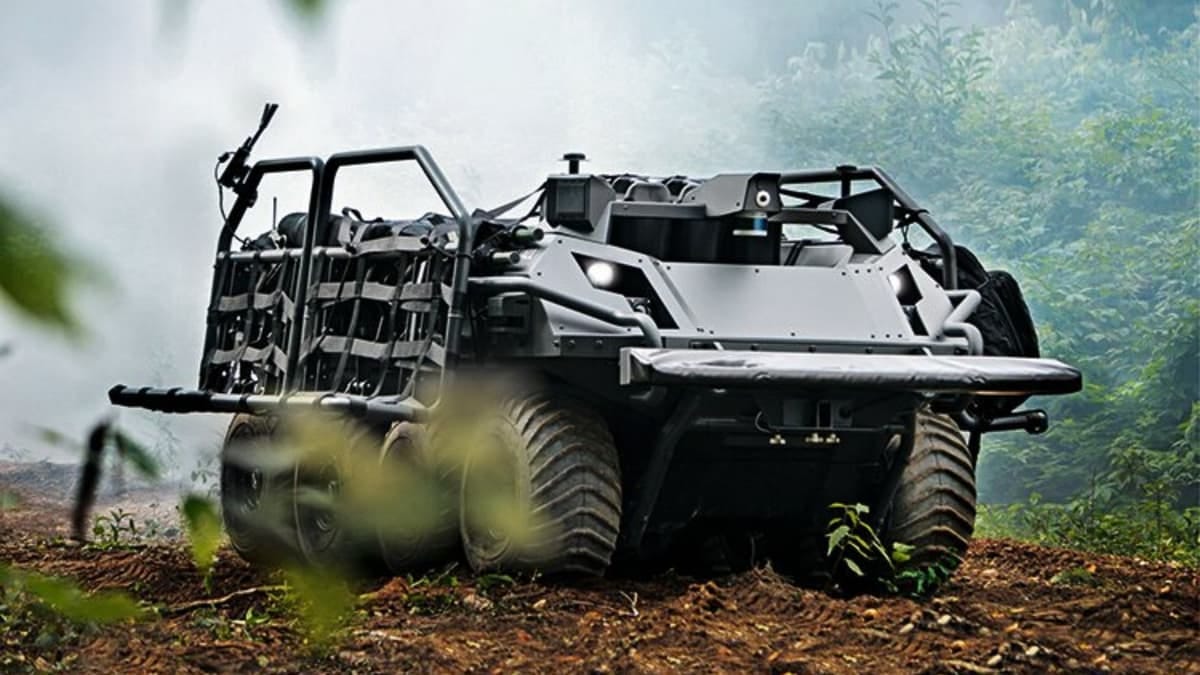Dispatch from the front line
Startups showcase battle-ready tech in Lviv, Ukraine
Last week, The Icebreaker was delighted to sponsor, and moderate a panel about Canada’s defence industrial strategy, at Ottawa’s GCXpo. Big thanks and congratulations to the team at Invest Ottawa.
This week, please join us at York University for the annual Ernest C. Mercier Lecture in Entrepreneurial Sciences.
🎯 Three-Shot Burst
Documentary filmmaker, former CEO of Intellectual Property Ontario, and friend of The Icebreaker Dan Herman, with an exclusive dispatch from Ukraine:
This past weekend in Lviv, not far from Ukraine’s western border with Poland, Ukrainian startup founders, investors and policy makers gathered for the country’s largest tech and startup event, IT Arena. Held at the city’s expansive football (ok, soccer for you) arena, the event showcases the country’s growing startup ecosystem, and in particular, its especially impressive defence tech sector.
According to the country’s Ministry of Digital Transformation, Ukraine now hosts over 2,500 startups, including approximately 800 focused on defence-tech. Of those defence-tech companies, over 100 produce AI-powered drones and over 200 focus on AI/ML defence solutions. The growth of this segment is part and parcel of a broader Ukrainian startup ecosystem that, despite the over 1000 days that have passed since the onset of the full-scale invasion in February 2022, has tripled in value to over $25 billion.
And while previous iterations of IT Arena have showcased every imaginable hardware application, this year’s event highlighted a significant evolution of capacity with respect to the application of artificial intelligence for defence, notably swarm technologies, machine vision and mesh networks. The three winners of this year’s defence-tech startup pitch were startups focused on these more sophisticated capacities, notably platforms for the integration of autonomous control systems, AI-based defence systems and mesh networks for unmanned robots.
The evolution of Ukraine’s startup system - from simple hardware through to complex, AI-enabled systems - in 3 years is something quite remarkable. However, in speaking to representatives from some of the dozens of defence-tech startups exhibiting their products at the event’s Defence Tech Expo, what’s clear is that this evolution is tied directly to the relationships that startups have been able to form with frontline units on the battlefield. Coordinated largely by Brave1, these relationships enable the rapid deployment, testing and subsequent iteration and redesign of products to best fit immediate operational needs. The result is a compression of traditional startup product development timelines from months to weeks, not to mention the achievement of hyper-targeted product-market fit.
As one foreign investor noted, “Drone companies in the West look like toys in comparison to what’s being developed here in Ukraine.”
This excellence in design and development has created demand from across Europe for Ukrainian defence tech. Hence co-production deals that Ukraine has signed with both Denmark and the United Kingdom. These are the first steps in sharing Ukraine’s drone-related expertise with its allies, albeit until the country’s export ban on defence products is lifted.
Bottom Line: Canada should get in line, quickly. For while efforts to spur the development of Canada’s defence-tech ecosystem are necessary, developing a strategic cooperation on defence tech with Ukraine would serve to both speed up and level up those domestic efforts by, for example, creating shared sandboxes for defence-tech innovations, promoting mutual soft landing programs for startups on both sides, and facilitating technology transfer and exports.
Canada can’t afford to wait to move on defence-tech, nor can Ukraine on the use of defence-tech exports to spur economic recovery and reconstruction. A strategic partnership on defence-tech makes too much sense.
Related:
The European Defense Tech Hub (EDTH) and The Icebreaker have joined forces to accelerate defence innovation, uniting Europe’s leading defence innovation network with Canada’s foremost defence tech community
How Ukraine is changing the face of war forever
ADVERTISEMENT
Dominion Dynamics is hiring. The company is building Canada’s next generation of sovereign defence technology, with a focus on Arctic sovereignty.
🤝 Sovereign Capability
Canada faces a once-in-a-generation opportunity to stake a serious claim in space
If we want to maximize the chances that our defence expenditures increase economic growth as well as security and sovereignty, we need to ensure we invest in the capabilities required to succeed in the future of warfare, not the past. For Canada to maximally benefit, we should invest primarily in domestic companies that produce new technologies with dual-use applications, including AI, space, quantum computing, nuclear, drones and robotics. Among these, space defence deserves priority – warranting at least 5 per cent of the targeted 5 per cent, or $7.5-billion annually by 2035.
There are four primary reasons why Canada should give significant priority to space systems as part of our national defence and dual-use industrialization strategy: the rising importance of space systems to national defence overall; Canada’s specific geopolitical and national defence situation; the growing economic global value of space systems; and the existing strength of the Canadian space industrial base.
The 3 Canadian Space Division, which was established in 2022 and is now under the command of Brigadier-General Christopher Horner, has already identified all the capabilities above – including counterspace systems – as essential for national security. We should make it a national priority to be second-to-none amongst our NATO and Five Eyes allies in the fielding and utilization of space defence assets.
Read the full piece.
Related:
After delays due to flames and boats, Canada to announce new window for first rocket launch
CDA Institute on the ongoing challenges of defence procurement… Defence contractors have promised to invest billions in Canada. Industry is still waiting
How will Canada spend $8.7B on defence?
Canada’s security and intelligence organizations face “significant challenges” detecting and responding to security threats because of legislative gaps and outdated resources
Canada has become a nation of digital sharecroppers
Does Canada need a sovereign wealth fund?
⚔️ Combat Readiness
Canadian ground robot survives Atlantic drop, reaches Portuguese shore successfully
Rheinmetall Canada tested a Mission Master 2.0 unmanned ground vehicle by dropping it from a warship into the Atlantic and driving it to a Portuguese beach.
The trial took place during NATO’s Robotic Experimentation and Prototyping using Unmanned Systems exercise on September 23. The drill gathered 24 countries and evaluated more than 276 unmanned systems for maritime operations.
The Portugal exercise highlights a broader interest in unmanned systems that can bridge sea and land. Militaries want robots that scout ahead, gather intelligence on beaches and littoral zones, and carry supplies during complex water-to-shore moves.
Related:
Our pals at North Vector Dynamics are hiring!
As China explores the Arctic, Canada’s military is preparing for confrontation
Arctic Training Centre gives companies a chance to trial defence tech in northern climate
Canada needs Arctic ports — the private sector can help:
Value for Money: Impact of Shipbuilding at the Halifax Shipyard—2025
Mr. Roboto: a16z says America cannot lose the Robotics Race… Canada’s Borealis initiative is elevating robotics as key to future security… Nvidia CEO says we are in a massive technology upcycle—AI, robotics, new materials, biomedicine. It’s as big a shift as going from muskets & cannons to tanks & aviation. Militaries around the world are retooling. Nations that miss this wave risk falling behind
The future of war? AI fighter jets trained in a matter of hours
U.S. Military Is Struggling to Deploy AI Weapons
The future of crewless naval warfare is being built in New England
🍁 State of Defence Tech 2025
Dealroom has produced a new report on the state of defence tech. Among the highlights:
European VC funding is projected to reach $2.3B by the end of the year, more than doubling the amount of funding reached in 2024. Mega rounds (including Helsing’s $600m round) make up three quarters of the figure.
The defence sector has grown from less than 1% of European venture funding before 2020 to 4% today, and as high as 6.2% in the EU this year.
Defence is the fastest growing VC sector in Europe, with a 132% increase.
Related:
NATO Innovation Fund (NIF) chairman Klaus Hommels is stepping down, now joining a new NIF advisory council as chair; former vice chair Fiona Murray will become chair
Can dual-use and aerospace become Europe’s innovation frontiers?… Germany unveils $40bn military-space investment
White House Places Quantum and AI at the Summit of R&D Priorities… Canada has a new AI Task Force… The US Defense Department has tightened cybersecurity requirements for tech companies that sell cloud computing services to the Pentagon. The updates, issued this month, ban IT vendors from using China-based personnel
Canada’s Reserves face a crisis, and our Navy is struggling to recruit… Bosses should urge workers to join Army reserves, says UK Defence Secretary. Why?:
👉 Build solutions with dual-use DNA.
👉 Shape products that are frontline-ready but commercially viable.
👉 Create pathways where reservists become the bridge between the latest innovation and the operational reality.
UK Defence and Security Accelerator (DASA) Open Call for Innovation: The Open Call is looking for innovative ideas to improve the defence and security of the UK. Your idea could be a concept, product or service, at various levels of maturity
Ukraine’s Plan to Starve the Russian War Machine… Europe turns to Ukrainian tech for ‘drone wall’ against Russia… US counter-drone defences ‘insufficient’ as China scales up unmanned capabilities
Military analysts estimate that drones account for 60–70% of equipment losses in Ukraine. This validates Noah Smith’s argument that mastery of the “Electric Tech Stack” has become essential for national defence in the 21st century
No bueno:
🔫 Hot Shots
ICYMI: The Icebreaker joined last week’s BetaKit Podcast to talk about why the Canadian defence tech sector is taking off, and how we’re building the ecosystem
What’s old is new again: Armed forces are turning to an 18th-century technology to snoop on enemies
Speechifying: Defence and security make up first pillar of Canada’s foreign policy, Anand tells UN… Canada must use scarce dollars to maximum effect… Zelensky warns world faces ‘destructive arms race’ with rise of drones, AI… PM Carney at the Council on Foreign Relations on Canada’s intent for defence spending:
When the lights go out: A retired NATO commander on how a global conflict could start… The next blackout may not come from a software problem. It could be an act of aggression… Cache of devices capable of crashing cell network founder near UN… China’s cyberattacks, electronic espionage subverting U.S. and its allies, report says… How China’s Secretive Spy Agency Became a Cyber Powerhouse:
American officials were alarmed in 2023 when they discovered that Chinese state-controlled hackers had infiltrated critical U.S. infrastructure with malicious code that could wreck power grids, communications systems and water supplies. The threat was serious enough that William J. Burns, the director of the C.I.A., made a secret trip to Beijing to confront his Chinese counterpart.
Bold bets: Economics 101 teaches that more guns usually means less butter… We should be clear-eyed about how much our future capabilities might cost… Atomionics attracts $12.7M Pre-Series A to fast-track resource exploration with quantum tech in Australia and North America… 500 years of Italian ‘defence tech’ innovation… The global nuclear renaissance… Defending defence is the hot new strategy in ESG investing… Steve Wozniak was in Toronto to talk rare earths
Spy tech: GeoSpy is an AI that can figure out where a photo was taken, sometimes down to the exact street, using nothing but the pixels… Wars of deception are coming for America. It isn’t ready… Vulnerable: is Canada’s telephony infrastructure all routed through the US?… All-In pod tackles defence with Google’s Eric Schmidt
Bad kids table: The possible link between U.S. Baltic security cuts and airspace incursions… Russia’s air war of flimsy decoys… Drones seen over Danish military bases in latest air disruption… Repeated drone incursions across Denmark, despite the country’s air prowess, exemplify the vulnerability of critical infrastructure across Europe… Russia is playing chicken in Eastern Europe, while helping prepare China to attack Taiwan, documents suggest… NATO’s air defence dilemma
If you’ve got battlefield intel, classified tips, or just want to call in an airstrike on our typos, hit “reply” and sound off. Whether it’s a new tech sighting, a rumour from the mess hall, or feedback on our comms, we want your SITREP.











https://open.substack.com/pub/thebluearmchair/p/slouching-towards-bethlehem?r=5kmhkr&utm_medium=ios